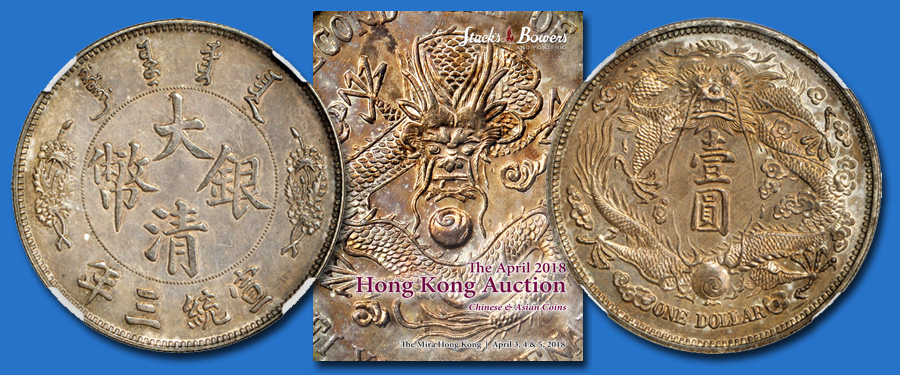
Our August Hong Kong Showcase Auction previews continue with this lovely
rare pattern Silver Dollar from the final period of the Chinese Empire and the
Qing (Ch’ing) Dynasty. The Central Mint in Tientsin minted a multitude of
coinage types in the later portion of the Empire, in an attempt to unify the
currency system of China. Unfortunately, China’s administrative disorganization
(as well as a lack of sufficient funds) inhibited the reforms from gaining
traction. Certainly the revolution overthrowing the monarchy later that year
also prohibited widespread use.
The new coinage would share many design elements with
preceding Imperial and provincial coinage but would have many simplified
elements meant to impart the message of continued Imperial authority throughout
China, an important message as the reigning Emperor Hsuan Tung was only six
years old at the time. This new coinage would bear an Imperial dragon (with
five toes on each foot) much like its provincial forebears, but this dragon
would dominate the entire face of the coin. The dragon glares out from 12
o’clock, its body wrapping and twisting throughout the periphery of the coin
while in the center is the denomination of one Yuan essentially encircled and
protected by the symbol of the Emperor. The inscription and legends also send a
stripped down clear message of Qing sovereignty.
The reverse design contains the Chinese and Manchu legends expressing all
of the necessary information for the piece. Between the outer crenulated border
and the inner pearled ring the Manchu and Chinese characters form the outer
legend. Four Manchu characters appear above, and four Chinese characters below
that state: “Hsuen Tung, 3rd Year” (1911), and these sets of
characters are separated by ornate floral sprays. The central Chinese
inscription states: “Ta Ch’ing Yin Pi” meaning: Great Ch’ing (Dynasty) Silver
Coin.
Once this initial design had been completed it went
through several refinements until the design was finalized. The first
modification was a slight tweaking of the calligraphy in the legends and
inscription, along with a redesign of some of the floral sprays flanking them. This
coin is from that first modified issue, with a noticeable difference in the
floral sprays on the reverse. Next the dragon’s whiskers were shortened so they
no longer surround the denomination at center, Kann also mentions seeing a
transition design in which the dragon bears medium length whiskers but this was
never struck in any significant quantity. The final stages of design are more
familiar to most collectors as the “Flying Dragon” dollars that share the same
composition as the earlier models but the dragon has been refined with a
smaller head, short wavy feelers and more realistically rendered clouds about
it. This final design was struck in great quantity at the Tientsin and Wuchang mints;
however the uprising of 1911 in the later city forced this new design to enter
circulation without ceremony as emergency military pay. Even after the
establishment of the Republic of China this dragon coinage continued to be
struck, as the new Republic dollars could not be produced quickly enough. Hence
the dragon dollars were struck up until the introduction of the Yuan Shih-kai
dollars in 1914. This example is beautifully struck with rich detail, faint
clear tone, and gleaming luster, and is sure to be a fine addition to the next
collection it enters.
Though our Stack’s Bowers August Hong Kong Showcase Auction is no longer
open for consignments, we are now accepting consignments of world and ancient
coins for our January 2017 New York International Auction as well as Chinese
and other Asian coins and currency for our April 2017 Hong Kong Showcase
Auction. If you are interested in consigning your coins and paper currency
(whether a whole collection or a single rarity) be sure to contact one of our
consignment directors.





